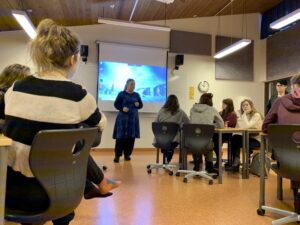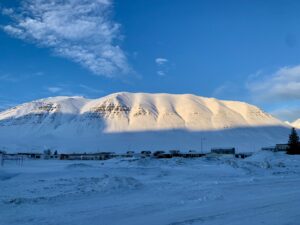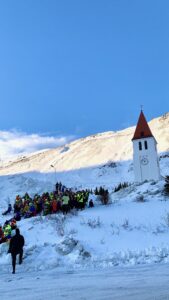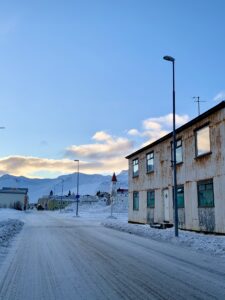The first visit we had today was to Menntaskóllin á Tröllaskaga, a public school in the town of Ólafsfjörður. It comprises around 70 in-school students and around 330 distance learners ranging between the ages of 16 and 20, managed by about 25 staff. Upon entry to the school, we removed our shoes and coats and split into groups to receive a tour. We looked through the classrooms, conversing with students as they studied in small groups. As we had arrived during the mandatory coffee break, several staff members were congregated in the staff room eating pancakes to celebrate the rising of the sun over the mountains (more on that later). We passed a distance teacher, teaching from Stockholm while being transported around on a rolling Skype-like machine. In his class, Philosophy, four students attend in-person class and the other 28 learn via Moodle online.
This blend of teaching styles can be hard for American students like us to grasp. Most teachers at the school utilise a “flipped classroom” method. In addition to this, apps and technology are centrally focused within the curriculum. In fact, the school’s motto is: Innovation, creativity, courage. They endeavour to not only focus on the preparation of students for university, but also for real life and the broad technological changes that will incur within these student’s lifetimes. As headmaster Lára Stefánsdóttir puts it, they “are preparing the students for the 4th industrial revolution. We teach them to cope in a society that uses a lot of technology, creativity, and innovation, so that they survive no matter what comes their way.” Learning to self-manage and to think outside of the box in an ever-changing world is at the core of their value.
Is this what all schools across Iceland are like? No, of course not. But there is something to be said here in the value of lifelong learning, adaptability, and communal existence. Lára said it herself, that this school would not survive alone without distance learners (each student pays $100 a semester to be a student here). Something in this way of teaching is attracting students semester after semester, year after year. Perhaps it’s simply a good school. But more likely, it has to do with the fact that this school values students as lifelong learners, not as teenagers who need to pass each test in order to prove their worth or capability as a learner. Most distance learners are students who have dropped out, gone off to work, are adults, or for some reason are unable to physically get themselves here. By opening the doors to these students, this school is able to provide learners with the opportunity to give their own education a chance. It views students as existing within a greater Icelandic and worldly community, rather than cutting off those who may not thrive in a “standard” educational setting. They work with the students. They teach them how to learn.
As our guide told us: “If we keep the door to education open, that’s different. That’s good.”

After our school visit, we had some time to walk around Ólafsfjörður. We were paired together and tasked with taking a photo that we thought represented the cultural landscape of the town. We later did the same in Siglufjörður.

My partner (Jessica) and I first took this photo in Ólafsfjörður. We reflected on the way that Ólafsfjörður seems to just shrink in among the mountains that surround it. There is really just one place where there isn’t a mountain shading the town: the small harbour. This, to us as visitors, seemed to be a very impactful thing to exist within.

Upon our arrival back to Siglufjörður, we were greeted by the sounds of the schoolchildren singing near the town square. This is a yearly event which takes place on the day when the sun once again rises above the mountain peaks and shines onto the rooftops of the homes in town. It was a sweet sight, to be able to watch children partake in a tradition that is so closely tied to the landscape of this place. Once again, we were reminded of the ways in which culture and landscape are so intrinsically connected, especially here in the north.
Prior to our last visit of the day, we paired up again to explore Siglufjörður. This time, Jessica and I were struck by the differentiation between the physicality of the buildings here in town. As discussed in previous blog posts, this town went through a significant economic change as herring fishing dissipated from the area. Now, as tourism endeavours to take its place, this transition is, in one of many ways, marked by the distinction between buildings. Our picture, taken nearer to the far docks, depicts what we think is a showing of the “layering” of Siglufjörður’s history: boom becoming bust, old replacing new, but still remaining rooted in the history of the bust.

Our final visit was to Primex, an Icelandic marine biotech company with several plants across northern Iceland. Established in 1999, their main action at the Siglufjörður location is the extraction of chitosen from North Atlantic shrimp. Chitosen is made from natural fibres of these shellfish, and because it has a unique positive charge, it can be useful in functions ranging from reducing fat, to slowing bleeding, and to clarifying wine. Going further from this scientific advancement, in terms of the impacts on Icelandic culture, cosmetic and medicinal products such as those,produced by Primex have aided Iceland in becoming synonymous with ideas of pureness, water, and natural sourcing.
Our lecturer, Ólafur Stefánsson, provided us with insight into the process of the extraction and the products it can create. But where our learning really flourished was during our discussion afterwards. A few points that were brought up:
What are the impacts of a globalised Icelandic company? Could this bust like herring fishing did?
Less likely. Because this has more of a safeguard, due to connections between countries such as Norway and Canada, the towns where these products are manufactured are more protected. Additionally, they are subject to a strict global standard (for instance, they are required to submit registration for each product as a cosmetic or medical device), which helps to keep them going globally, and on track with others. Ólafur remarked that in fact, it is better to have many smaller corporations, such as Primex, instead of a few large ones, as the economic downfall wouldn’t necessarily be so widespread.
How sustainable is this? Are there any critiques?
Of course there are critiques to every situation. But at least as far as carbon footprint goes, like many companies and buildings in Iceland, the plant is run on hydropower. They have been discussing the long term impacts of their manufacturing, but it seems to be much less of an impact than other places. Their only critiques were the smell and the fact that their pipes have leaked out a faint pink colour of the shrimp that they manufacture. But these seem to be fairly minor incidents, and do not heavily negatively impact society or the environment.
Today, what was very apparent to me were the ways in which history and progress align. Whether it be in broadening teaching varieties, new architecture, or expanding scientific resources, time continues to move every town forward. But there are some things that will always remain: intrinsic connection to the Earth, through mountains or sunshine or singing; reminders of history through physicality or story; the re-emerging light reminding us of the renewal of each timeline. What a rich environment to see history and progress, and landscape and culture interweave.
Leave a Reply
You must be logged in to post a comment.